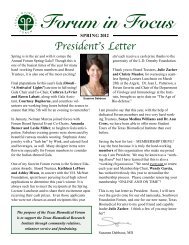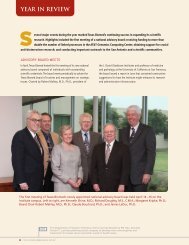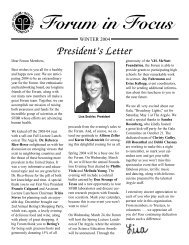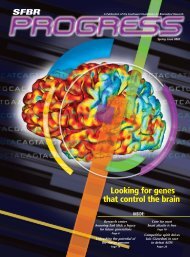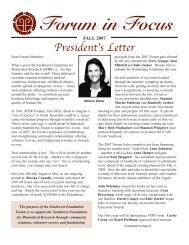Texas Biomed Science Report 2011-2012 - Texas Biomedical ...
Texas Biomed Science Report 2011-2012 - Texas Biomedical ...
Texas Biomed Science Report 2011-2012 - Texas Biomedical ...
You also want an ePaper? Increase the reach of your titles
YUMPU automatically turns print PDFs into web optimized ePapers that Google loves.
Michael C. Mahaney, Ph.D.<br />
Scientist, Genetics<br />
Employing statistical genetics and genomics tools, Mahaney’s research<br />
exploits data on a variety of phenotypes from multiple species to<br />
address questions with implications for basic biology and biomedicine.<br />
Phenotypes studied include biomarkers of metabolic processes — such<br />
as lipid and cholesterol metabolism, inflammation, oxidative stress,<br />
and cell growth — and cell structure and function. These data inform<br />
research relevant to cardiovascular diseases, like atherosclerosis and<br />
stroke, and age-related disorders of bone, such as osteoporosis. The work<br />
is typically comparative: Mahaney and collaborators use results from<br />
analyses of data from one species (e.g., humans, baboons, laboratory<br />
opossums, and/or mice) to generate hypotheses that they test in another<br />
to understand the genetic bases of variation in human health and disease.<br />
Mahaney has long been interested in identifying genes or sets<br />
of genes that influence multiple traits (pleiotropy). This interest<br />
motivated his early work to detect pleiotropic effects of the cystic<br />
fibrosis locus on growth and development of children with that<br />
disease; later efforts to detect the effects of genes on variation in<br />
shape, size and number of teeth; and current studies to identify<br />
and understand the effects of the genes contributing to variation in<br />
susceptibility, severity, and progression of common, complex disorders<br />
in humans. Although primarily analytical, his research also takes<br />
him into the field, as in a current study to identify genes influencing<br />
the structure and metabolism of bone in the people of Jiri, Nepal.<br />
Coordinately regulated networks of phenotypes and the genes<br />
that underlie them are likely to be good targets for preventive and<br />
therapeutic intervention. Analyzing data from humans, baboons,<br />
and mice, Mahaney and Staff Scientist Magalie Leduc are using<br />
multivariate statistical genetics and bioinformatics tools to reconstruct<br />
<strong>2011</strong>–<strong>2012</strong> Scientific <strong>Report</strong><br />
“Each human is a product of billions of reactions on multiple levels of biological organization<br />
and interactions between all the levels. Networks of interacting genes provide the blueprints for observed<br />
patterns of correlations between clinically relevant phenotypes in health and disease.”<br />
Staff<br />
Left to right: Natalia V. Milshina,<br />
Magalie S. Leduc, Michael C. Mahaney<br />
Publications<br />
• Vinson A, Curran JE, Johnson MP, Dyer TD, Moses EK, Blangero J, Cox LA, Rogers J, Havill<br />
LM, Vandeberg JL, Mahaney MC (<strong>2011</strong>) Genetical genomics of Th1 and Th2 immune<br />
response in a baboon model of atherosclerosis risk factors. Atherosclerosis 217:387-94.<br />
• Hlusko LJ, Sage RD, Mahaney MC (<strong>2011</strong>) Modularity in the mammalian dentition: mice and<br />
monkeys share a common dental genetic architecture. J Exp Zool B Mol Dev Evol 15:21-49.<br />
• Rainwater DL, VandeBerg JL, Mahaney MC (2010) Effects of diet on genetic regulation of<br />
lipoprotein metabolism in baboons. Atherosclerosis 213:499-504.<br />
• Charlesworth JC, Curran JE, Johnson MP, Göring HH, Dyer TD, Diego VP, Kent JW Jr,<br />
Mahaney MC, Almasy L, MacCluer JW, Moses EK, Blangero J (2010)Transcriptomic<br />
epidemiology of smoking: the effect of smoking on gene expression in lymphocytes.<br />
BMC Med Genomics 3:29.<br />
• Rainwater DL, Shi Q, Mahaney MC, Hodara V, Vandeberg JL, Wang XL (2010) Genetic<br />
regulation of endothelial inflammatory responses in baboons. Arterioscler Thromb Vasc Biol<br />
30:1628-33.<br />
• Rainwater DL, Cox LA, Rogers J, VandeBerg JL, Mahaney MC (2009) Localization of multiple<br />
pleiotropic genes for lipoprotein metabolism in baboons. J Lipid Res 50:1420-8.<br />
• Sherwood RJ, Duren DL, Havill LM, Rogers J, Cox LA, Towne B, Mahaney MC (2008) A<br />
genomewide linkage scan for quantitative trait loci influencing the craniofacial complex in<br />
baboons (Papio hamadryas spp.). Genetics 180:619-28.<br />
these sorts of networks. Focused mainly on cardiovascular disease risk<br />
factors, these efforts already have identified networks of genetically<br />
correlated traits that respond to different levels of cholesterol and<br />
fat in the diet of our pedigreed baboons. They also have identified<br />
networks of genes, often hundreds, which affect variation in these<br />
responses. Similar analyses were used to identify gene co-expression<br />
networks that influence two kinds of immune-response cells that<br />
may play roles in atherosclerosis. With different sets of bioinformatics<br />
tools, he and Staff Scientist Natalia Milshina also have been studying<br />
specific classes of mutations likely to affect the ways in which some<br />
genes in these networks may simultaneously affect many others<br />
and, consequently, our risk for developing cardiovascular disease.<br />
E For more information, please visit www.txbiomed.org/departments/<br />
genetics/genetics-staff-bio?u=2<br />
19



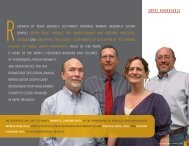
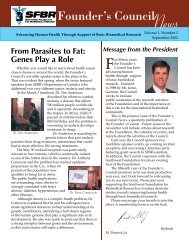
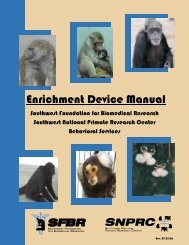
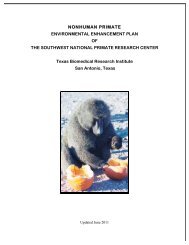
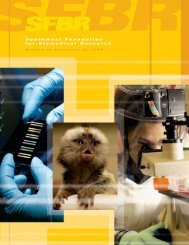
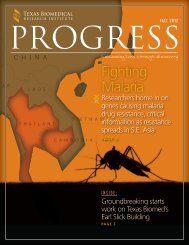
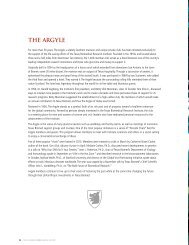
![Vol. 8 No. 2, 2011 [PDF] - Texas Biomedical Research Institute](https://img.yumpu.com/35688099/1/190x245/vol-8-no-2-2011-pdf-texas-biomedical-research-institute.jpg?quality=85)
